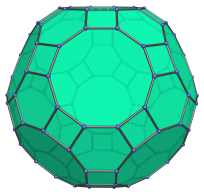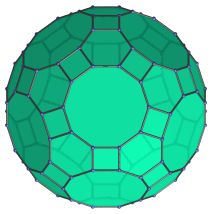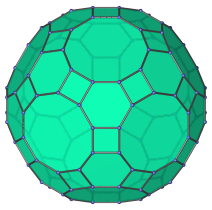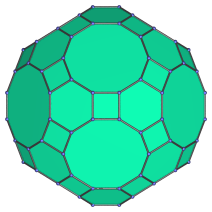The Great Rhombicosidodecahedron
The great rhombicosidodecahedron is a 3D uniform polyhedron bounded by 62 polygons (20 hexagons, 30 squares, and 12 decagons), 180 edges, and 120 vertices. It may be constructed by radially expanding the decagonal faces of the truncated dodecahedron outwards, or equivalently, radially expanding the hexagonal faces of the truncated icosahedron, or the square faces of the rhombicosidodecahedron.

The great rhombicosidodecahedron is also known as the truncated icosidodecahedron; however, this name is a misnomer, because truncating the icosidodecahedron does not yield a uniform polyhedron, only a non-uniform topological equivalent of the great rhombicosidodecahedron. The correct derivation is as described above. Note also that there is a non-convex polyhedron known as the “great rhombicosidodecahedron”, which should not be confused with this convex polyhedron.
The dual of the great rhombicosidodecahedron is the disdyakis triacontahedron, one of the Catalan solids.
Projections
In order to be able to identify the great rhombicosidodecahedron in various projections of 4D objects, it is useful to know how it appears from various viewpoints. The following are some of the commonly-encountered views:
| Projection | Envelope | Description |
|---|---|---|
 |
Icosagon | Parallel projection centered on a decagonal face. |
 |
Icositetragon | Parallel projection centered on a hexagonal face. |
 |
Dodecagon | Parallel projection centered on a square face. |
Coordinates
The Cartesian coordinates of the great rhombicosidodecahedron, centered on the origin and having edge length 2, are all permutations of coordinates and changes of sign of:
- (1, 1, 4φ+1)
together with all even permutations of coordinates and all changes of sign of:
- (1, 3+2φ, φ3)
- (2, φ4, φ2)
- (φ2, 2φ2, 3φ)
- (2φ, 2+φ, 1+3φ)
where φ=(1+√5)/2 is the Golden Ratio.
Occurrences
The great rhombicosidodecahedron occurs as cells in the following 4D uniform polytopes:




